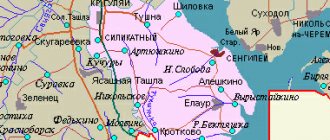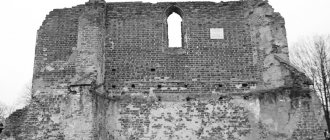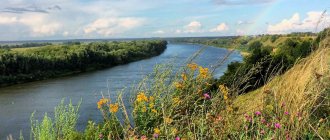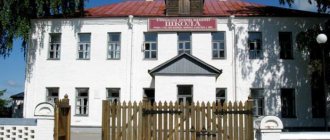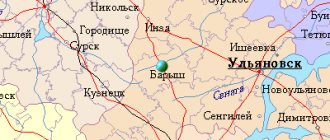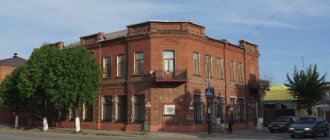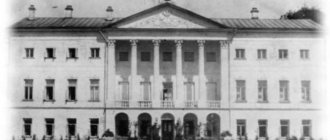Shatsk
Sights of Shatsk
One of the interesting places in Shatsk is the Cathedral of the Resurrection of Christ
, which was built at the end of the 18th century and reconstructed in the first half of the 19th century. Under Soviet rule, the temple was closed and partially destroyed, and is currently used as a bus station.
Not far from it is the wooden church of St. Nicholas the Wonderworker
, built back in 1600 and preserved in its original form until the beginning of the 19th century.
In 1838 it was strengthened and expanded; in the 30s of the 20th century it was closed, but in wartime it became operational again and is still open to believers.
Trinity Cathedral attracts attention
. It was built at the end of the 18th century at the expense of the merchant Milovanov and expanded in the mid-19th century with the financial participation of parishioners. In the 20th century it was closed, in 1993 it was again transferred to the Orthodox Church.
Near the city cemetery there is an elegant Assumption Church
. It was erected in 1843 with the money of local merchants. In the 30s of the 20th century, the temple was closed, and since 2000 services have been held here again.
A very beautiful building, which was built in the first half of the 19th century, stands on Republican Street. The Theological School was previously located here.
, but after the revolution it was closed. Now there is a cultural school here.
Another place that attracts tourists in the city is the “Pissing Boy” fountain.
. It appeared here in 2012 and is very similar to its more famous Brussels brother.
There are a lot of interesting things in the Shatsk region. One of the most striking attractions is the Naryshkin estate “Bykova Gora”
.
The wooden manorial estate with lancet windows, semi-columns, balconies and galleries has survived to this day. The ancient mansion is recognized as an architectural monument of the 18th-19th centuries.
Very close by in the village of Vysha is the Vyshensky Assumption Convent
. It was founded in 1625 and was originally male.
The first church appeared here at the end of the 18th century, and in the 19th century. — three more churches and a bell tower. In the 20th century, the monastery was closed, the property was nationalized. In 1990, a convent was opened here.
You can get to know the Shatsk region better at the Zhelannovsky Local Lore Museum
, founded in 1958 as a school and gradually expanded to a district scale.
The museum's collections contain many ethnographic and archaeological exhibits, as well as household items, photographic materials and works of local artists.
Another popular place among tourists is the Borkovskaya hydroelectric power station.
on the Tsna River. During its construction, the Borkovo reservoir was formed.
Another reservoir - Zatonskoye at the Zatonskaya hydroelectric station
— located on the Vysha River near the village of Maryino. Currently, hydroelectric power stations are not operational and are partially destroyed.
On the banks of the Tsna River there is another Shatsk shrine - the Nikolo-Cherneevsky Monastery
. It was founded at the end of the 16th century by the Don Cossack Matthew and was originally called the Matthew Hermitage.
The architectural ensemble of the monastery has preserved religious buildings of the 18th-19th centuries.
In the place where the city stands today, the so-called “Shatsk Gate” has long existed. Obviously, this was a small fortification - a fort, which blocked the steppe inhabitants’ path into the depths of Rus' (in this place there was a clearing between the forests). But the Shatsk Gate, of course, could not resist large enemy forces, and therefore, after another Nogai attack on Old Ryazan in 1551, Ivan the Terrible ordered governor Boris Sukin to establish a fortified settlement here. Thus, Shchatsk, as the extreme eastern point, became part of the so-called Tula serif line.
Typically, such fortifications had a signal tower, which was usually located on an elevated place. When steppe nomads appeared, a signal fire was lit on the tower, the smoke of which was visible 10 - 15 miles away. So the lookouts warned the surrounding villages and border governors about the approach of the enemy. In our case, the position of the fortress was chosen very conveniently. From Cathedral Hill (now there is a bus station) there was a wide view of the steppe region, with Shacha flowing below. “The river was full then,” wrote Shatsk local historian Yu. Romanovsky, “the ravines surrounding the hill were filled with water and presented a serious obstacle to the enemy. Near the building of the former branch of the state bank, you can still see the remains of a ditch, which also ran next to the former house of pioneers and connected the ravine with the present-day Krasnaya Slobodka.
There were two underground passages leading from the fortress. One went into the ravine of the former Shchemilovka (now Krasnaya Slobodka), the other into the ravine separating Shatsk from Yamskaya Sloboda. So during a long siege, the warriors could either make a sortie from the fortress, going behind enemy lines, or escape.
Little by little the prison began to grow. The first settlers were gunners, archers and Cossacks. Economic development of the region took place under their protection.”
The Shatsk Gate, and later the city of Shatsk, got their name from the Shachi River. In ancient times, the river had a slightly different name - Shatya. It is believed that the Shach variant was first used in 1627 in the “Book of the Great Drawing”.
The first settlers in Potsenye (i.e. along the Tsna River) were Mordovian tribes, who gave names to local rivers, lakes, tracts, and villages. However, scientists still do not have a consensus on the origin of these names.
For example, P. N. Chermensky produces Tsna from the Mordovian word “tantsti”, which means “delicious”. S. N. Sergeev-Tsensky - from “mud”. There is also an opinion: “Tsna” is a Slavic name and means “right”. In ancient times, the Russians called the right hand the right hand (hence the Desna River - “right”). Also, our Slavic ancestors, moving from the east, probably considered Tsna as the right tributary of the Oka, and Moksha as the right tributary of the Tsna. In fact, if you look at the map, you can see that it is not the Tsna on the left that flows into the Moksha, but the Moksha, the right tributary of the Tsna, and then the Tsna-Moksha waters flow into the Oka.
Some historians derive the name of the Shacha River, and then the city of Shatsk, from the Mordovian word “shachims” - well born (P.N. Chermensky). Others derive from the Mordovian “shan” - a favorable, generous place. Probably based on this version, a legend appeared that supposedly the Mordovian who lived here loved to swim in the morning. That’s why the river was named “Good morning” – Shacha in Mordovian. Still others hear the neighing and stomping of horses in the name, because in the local dialect the word “shatskat” means urging horses to pasture. It is also possible that it is based on the Tatar “shat” - a branch of a river, a fork of a river.
Here's an interesting point. Strange as it may seem, the name of the city of Shatsk echoes the name of the city of Sochi. We can find out about this in the “Historical and Toponymic Dictionary of Russia” (M. 2000, p. 170) by E. M. Pospelov. As in our case, the city on the Black Sea coast is named after the Sochi River, which, in turn, received its name from one of the local tribes, Shacha, Shacha. Over time, Shacha transformed into Sochi. But Pospelov, unfortunately, does not say how the word is translated and whether it has any connection with our Shacha.
And one more interesting page of history. This was in 1924. Then the city almost changed its name. On January 27, the general meeting of Shatsk introduced a resolution to rename one of the city streets to Lenin Street; installation of a monument to Comrade Lenin; “to call the gate leading to the “Peasant’s House” “Ilyich’s Gate””, and “to petition the All-Russian Central Executive Committee to rename the city of Shatsk to the city of Ulyanov.”
We now know how it all ended. The city remained with its own, albeit not yet clear, but glorious name.
In ancient times
The Shatsk region is a plain stretching in the center of Russia, on the Oka-Don lowland.
At the turn of the 1st millennium BC and the 1st millennium AD, Finno-Ugric tribes came from the east and settled Potsenie and lands in the Moksha basin. On their basis, the ancient Mordovian tribes arose. The places here were convenient for living: forests rich in game, fertile soil, and an extensive river network that made it possible to trade with neighbors.
In the 8th century, in the areas of the lower Oka, Tsna, and Shachi, Slavic tribes appeared, which gradually mixed with the Mordovians. Historian P.N. Chermensky points out that in the 9th century more than 15 percent of the Slavs already lived among the Meshchera and Mordovians. Under the pressure of the Slavs, the Mordovian tribes retreated into the forests to the north. The remaining part of this people lost their language, their way of life and became Russified.
During the power of the Kyiv state (IX-XI centuries), the Kyiv princes often came to the basin of the Oka River and its tributaries. In 964, the Kiev prince Svyatoslav conquered the Vyatichi and other peoples living along the Oka and Tsna. Some of his detachments came to the Shacha River for tribute.
In the 11th century, Polovtsian raids began on Rus'. The population of the south flees to the north, settling along the Oka, Tsna, and Shacha. The fight against the Cumans continued until the arrival of the Mongol conquerors.
In 1236, Khan Batu came from Central Asia. He ruined the Volga Bulgarians. From the Volga he went along the rivers Sura, Moksha, Tsna, Shacha, conquered all the peoples living here, and imposed tribute on them.
In 1239, the Tatars again came to the Ryazan lands, conquered the Mordovians, and the territories along Moksha and Tsna became the feudal possessions of the Tatar princes.
After the Battle of Kulikovo, in 1382, Khan Tokhtamysh appeared on Shatsk territory and went from here to Moscow. Tamerlane’s troops passed through our land more than once; he plundered the population living in Tsna and Shacha. There was a strong attack by the Tatars in 1414. The chronicles of this year mention the village of Algasovo as the inheritance of the Grand Duchess, the wife of Dmitry Donskoy. The Nikon Chronicle describes the battle on Listani in 1444 (now the Listvyanka River near the village of Glebovo). “And the Mordovians came at them on their mouths (i.e. on skis), with sulitsa and with slingshots and with sabers, and the Ryazan Cossacks also on their mouths with sulitsa and with slingshots and with sabers on the other side... And the battle was great and strong for them on the river on Listani, and they began to overcome the Christians and beat up many Tatars, and killed Tsarevich Mutafa himself and killed many Tatar princes with him.” This battle, famous in history, is notable for the fact that the Ryazan Cossacks are mentioned in it. Perhaps these are the ancestors of the inhabitants of Cossack Sloboda, who fled to the Wild Field from serfdom and became Cossacks.
After the expulsion of the Tatars, the Russian princes again launched an attack on Oka, Moksha, and Tsna. As they moved up the Moksha, the Mordovian princes obeyed the Moscow ones, and the Tsensky princes obeyed the Ryazan princes.
In 1521, the process of unifying Russian lands around Moscow was completed with the annexation of the Ryazan principality. During this period of time, the state was divided into counties (territories close to principalities), and counties into volosts. The territory of the current Shatsky district was part of the Verkhnetsensky palace volost with its center in the village of Konobeevo. It was a vast forest-steppe region. Along the banks of the Tsna and Shachi rivers grew dense pine and oak forests, adjacent to the Murom and Nizhny Novgorod forests. To the southeast of Shacha stretched boundless steppes that abutted the Lower Volga region and the Northern Caucasus. Verkhnetsenskaya volost was the southeastern border of the Russian state.
The process of colonization south of the Oka intensified in the 16th century after the final collapse of the Golden Horde. The Russian population, until then concentrated north of the Oka, gradually penetrates Tsna. A. Potapov in his book “Guardian City on the Zapashny Line” points out that “the composition of the population was very diverse. People seeking a free life flocked to the Ryazan “Ukraine,” from whom Cossacks, peasants who suffered from feudal oppression, servicemen, and fugitive criminals later formed.” Living in the border region was dangerous. After the collapse of the Golden Horde into khanates, Rus' was subject to raids by the Crimean Tatars and Nogais. And their path lay through our lands.
Even under Ivan III, all people wishing to settle in the southern part of the Moscow state were given preferential certificates. The settlers received land and were temporarily exempt from taxes. Military personnel with their wives and children were sent to the south of the Moscow state for eternal settlement. The military did not always travel willingly, but often on the orders of the sovereign. Thus, one decree states: “...and some of them do not want to go, and they are ordered to be sent into captivity, and punishment for disobedience is ordered: to be beaten with batogs and sent to prison.” Landowners and serfs also resettled.
In 1534, the chronicle mentions the struggle between Ivan the Terrible’s mother, Elena Glinskaya, and her brother-in-law Yuri. The latter had a large army and a city on the Tsna River near the village of Borki, but its name is not mentioned. Some historians believe that it was called Shatsk. From this city, Yuri went to Moscow, but his army went over to Glinskaya’s side, and Yuri was arrested. The word “city” means a small fenced settlement, a wooden and earthen city.
Founding of Shatsk
At the beginning of the 16th century, on the southern and southeastern border of the Russian state, to protect against the Crimeans and Nogais, a system of military-engineering defensive structures was created - the Big Zasechnaya Cherta (BZCH). It was a single, very complex defensive complex, consisting of fortified cities, forest and water barriers, and specially created fortresses. Particular attention was paid to protecting the gates placed on the roads from the “Wild Field” into the interior of Rus', which are in the southern part of the BZCh. at the end of the 16th century there were 30. The gates—leaf or shield-shaped release “blocks”—were supplemented with earthen ramparts, ditches, trenches, arc forts, gouges, and watchtowers. The total length of the war zone was more than 600 miles. Its southeastern part consisted of Kadomskaya, Ryazhskaya and Shatskaya settlements (with a total length of 300 versts). The Shatskaya abatis stretched for 100 miles. It had 6 guards: 3 near and 3 distant and ran from Krivoy Polyana to the Para River. Fortress cities are being built on the BZCH.
In 1550, the government of Ivan the Terrible made a decision to allocate land to 1,000 nobles. (The decree reads: “Distribute estates... from Moscow 60-70 versts and further to the boyar children and the best servants). After this, the boyar children came to the Shacha River.
They had orders from the tsar to found a fortress no closer than 400 versts from Moscow, with a good overview of the area and with natural barriers against the Crimean Tatars and Nogais. The governor's attention was attracted by the high hills on the left bank of the Shachi; they allowed a far view of the area and were protected by deep ravines and a deep river. Most likely, there was a watchtower on one of the hills, from which observation was carried out, and if the Tatars appeared, a signal fire was lit. It was decided to build a fort city on the southern hill (Red). From the chronicle it is known that the city was founded on St. Nicholas the Great in 7061 from the creation of the world, i.e. in 1553 on May 9 according to the old style, May 22 according to the new style. “Boris Ivanov, son of a Sukin, built a city on Meshchera in the Shatsky Gates on the Shat River. The Lvov Chronicle says that “he knew the correct measure and the building part.”
Several houses were cut down in the area of the current bus station. They built a fortress with double oak walls. Stone and earth were poured between the fences, a plank roof was made above the wall, and the fortress was surrounded by an embankment with a palisade. A ditch was dug on the northern side, connecting the ravine with the river; in case of danger, water was poured into it.
The settlers were Orthodox people. In the southeastern part of the fort, a church was built, consecrated in the name of the Resurrection of Christ. It became the Collegiate Church.
The city was completed in a few months. From Ilyin's day, a governor was appointed for 1 year - Prince Ivan Fedorovich Mezetsky.
The city received its name from the Shatya River. The etymology of the word is controversial. Pyotr Nikolaevich Chermensky believed that it came from the Mordovian word “shachims” - to be born well. A. Potapov in his book gives several versions of the name - from the Mordovian word “shanya” - a favorable place, from the verb “shatskat” - to drive horses; from the Tatar word “shat” - river branch. There are also versions from the Slavic word - “to stagger”, i.e. hesitate, do not have a direct line of action, and from the Tatar phrase - “shacha” - pure water.
A garrison was stationed in Shatsk. Already in 1554, “uninvited guests” came to the walls of the fortress. The Tatar attack was repelled. After this, the garrison was strengthened. The city contained such a strong garrison that in 1565 troops were sent from it to help Prince Temryuk of Cherkassy, father-in-law of Ivan the Terrible. It is known from the chronicle that in 1571 the Crimean Khan Devlet Giray marched towards Moscow through our land, the guard patrols of the Shatsk abatis discovered the Tatar army, the signal was transmitted to Moscow. The Shatsk garrison was preparing to give battle, but Giray dodged it. He approached Moscow and burned it. The following year he again went to Rus' and was defeated at the Battle of Molodi (July 28 - August 2, 1572). 50 Shatchan took part in this battle.
In 1594, the “Nogai and Azov Turks” approached Shatsk, but were repulsed by the governor Prince Koltsov Mosalsky. In June 1656, the Azov and Crimean Tatars approached Shatsk, captured a small number of “horse and livestock herds,” but were repulsed.
In total, in the 16th-17th centuries, the Tatars and Nogais made 43 major raids within the Ryazan land. Shatsk was never taken. The strong oak walls helped a lot. And the strong garrison repelled many attacks.
The first settlers in the city were archers, gunners, and Cossacks. They formed the settlements: Pushkarskaya, Cossack, Streletskaya, Yamskaya. With their participation, the economic development of the region was carried out.
In April 1636, Shatsk carpenters, one person from five households, under the protection of Konobeevsky Cossacks, founded the city of Tambov.
An inventory made in 1672 gives the following description: “Shatskaya Zasekaya, new, on the Polish side from Krivaya Polyana to the Cossack fort and to the Shatsk city near the Yamskaya Sloboda 6 versts, and from the Yamskaya Sloboda on the Russian side to the Pary River 90 versts, and across from the Shatsk city and opposite the Pankovskaya gap is half a mile, and opposite the village of Prolomu through Borshchova Polyana to Krivaya Polyana from line to line for a mile, and from Krivoy Polyana to the Paru River to the Lipskie Zasaki castle...”
The fact that Shatsk was a significant city is evidenced by the fact that when Moscow proclaimed Mikhail Romanov tsar in 1613, Shatsk residents were among those elected to the Zemsky Sobor. And the Shatsk governor Alexey Ivanovich Zyuzin received extreme honor: in the same 1613 he was sent as an ambassador to England to King James Stuart with the news “about the accession of the young king to the throne and with complaints about the lies of the Polish and Swedish kings.” Another governor, Roman Fedorovich Bobarykin, in 1636 supervised the foundation of the city of Tambov “beyond Shatsk in the steppe,” where the “extreme Mordovian village of Tonbova” was located. Shatsk Cossacks and peasants worked there - one person from five households. The new fortress that was built was inhabited by Cossacks from the village of Shatsk. Konobeeva.
Development of Shatsk
In the XVI-XVII centuries. In the area of the ancient Pritsninsky region, small and large landholdings were formed, belonging to military personnel and church feudal lords. Only the Cherneevsky monastery, founded in 1573, 18 versts from Shatsk, already 100 years later owned four villages, in which there were more than 650 households, had 1,116 acres of arable land and 244 acres of meadows, “and a black forest with all sorts of land... and with the Orlovs nests, and with beaver ruts and elk stalls...” When, by the beginning of the 18th century. the local lands are no longer exposed to the dangers of Tatar-Nogai raids; the highest ranks of the Russian hierarchy receive estates here. For example, Empress Elizaveta Petrovna generously endowed Shatsk estates to Count Kirill Razumovsky, the last Little Russian hetman. His main estate was located in the village. Taradei.
In October 1670, ataman Stepan Razin appeared in the vicinity of Shatsk. He and his army settled in the village. Konobeev. From here they launched an attack on Shatsk, but were defeated by government troops. One of Stepan Razin’s letters states that he considered s. Konobeevo as his main stronghold, from where he “thinks... to go with the whole assembly to Moscow.”
In 1774, the uprising of Emelyan Pugachev reached the Shatsky district. They were waiting for the Pugachevites in Shatsk itself. Slingshots were quickly placed around the city and day and night guards were established. “Everyone,” reported the Shatsk prosecutor Selikhov, “came into timidity and great embarrassment, for many surrounding residents were leaning toward that rebellion.” However, Count Panin, who personally arrived here and was appointed by Catherine II herself as the commander-in-chief of the military forces to suppress the movement led by Pugachev, “pacified” the district.
In 1708, Shatsk was assigned to the Azov province, which in 1725 was renamed Voronezh, and in 1779 it was appointed a district town of the Tambov governorship, and then the Tambov province. Receives his own coat of arms. “In the middle part of the shield,” it is said in the Regulations about it, adopted in 1781, “there is a hive in the field and above it there are three golden bees; the earth is green. At the bottom of the shield are two sheaves of rye in a silver field, placed crosswise, as a sign of its great abundance.”
Describing the city of Shatsk as of no later than 1807, the “Geographical Dictionary of the Russian State, collected by Afanasy Shchekatov” reports that there were five churches there. It was inhabited by 157 merchants, 389 coachmen, 15 burghers, 751 “landowner peasants” and 1,492 “single-household peasants” - also peasants, but only state-owned, from former archers, gunners and other service people.
In 1787, the Small Public School was opened in Shatsk, consisting of two classes, where children of nobles, merchants and clergy could study. But it also ceases to exist in 1790. “Statistical image of cities and towns of the Russian Empire” under 1825 shows the presence of “one educational institution” opened in Shatsk along with “a charitable institution and six taverns and drinking establishments.” At the same time he informs that there is no bathhouse.
In 1833, on his way to Orenburg to collect materials for “The History of Pugachev,” A.S. passed through Shatsk. Pushkin. According to some scientists, in Shatsk Pushkin took the surname Shvabrin for one of the characters in The Captain's Daughter. There have been Shvabrins in Shatsky district for a long time. This surname is still found among the natives of the Shatsk region.
Trade and crafts are developing both in Shatsk and in the villages. The auctions for the sale of hemp that took place in the city were all-Russian. People came here for her from Nizhny Novgorod, Kaluga, Tver, even from Vologda and Arkhangelsk. The goods were loaded onto ships at the Koshibeevskaya pier and sent by water along the Tsna to the Oka and further to the Volga. In the village Shamorga and others, the manufacture of sheepskin flourished, in the village. Polnoye-Yaltunovo - carpentry, gardening and nursery farming.
During the era of peasant liberation, there were many large latifundia in the local district. So, Prince P.I. Trubetskoy, whose estate was located in the village. Pechin, had 33.5 thousand acres of land in Shatsk district, a landowner from the village. Borki A.D. Bashmakov - 27 thousand dessiatines. Chief Marshal and Chief Chamberlain E.D. Naryshkin owned 120 thousand acres of land in Shatsky and Morshansky districts. Even after allocating land to the peasants, according to the reform of 1861, he retained 51.5 thousand dessiatines.
In Shatsky district, the valuation of the lands of state peasants is determined to be 2.5 times, and the profitability is 3 times lower than that of landowner peasants, when redemption payments are assigned. And former landowner serfs made up about 83% of the peasant population of Shatsk district.
The book “Cities of Russia in 1910” characterizes Shatsk as follows: the population is 5282 people, “197 ordinary people have the right to vote in elections.” There are 879 residential buildings in the city, including 27 stone, and 206 thatched. The total length of the streets is 15 versts, while 0.3 versts are paved. Lighting: 60 kerosene lanterns. The average city budget for three years is 25 thousand rubles in income, but at the same time more than 50 thousand rubles are credited to it. debt. There were eight Orthodox churches in the city at that time.
The news of the February bourgeois-democratic revolution of 1917, the overthrow of the tsar, reached Shatsk in March. The bodies of the Provisional Government, the district Council of Workers' and Peasants' Deputies, were immediately created. In the Council and in its executive committee, headed by landowner D.I. Stakheev from the village. Agishev, the majority were Social Revolutionaries. There was no Bolshevik party organization in the district at that time.
By the winter of 1917, soldiers returned to Shatsky district. A Military Revolutionary Committee is being created under the chairmanship of the former Baltic Bolshevik sailor AM Kornilov, originally from the village. Cossack Sloboda. In the last days of December 1917, the committee, supported by military personnel of the local guard company, seized the institutions of the Provisional Government in Shatsk by force of arms and called elections to the Second District Congress of Soviets. It took place on January 10, 1918 in the building of a real school and officially consolidated the transfer of power to the Bolsheviks. AM Kornilov is appointed Chairman of the Executive Committee.
The transition to the socialist system took place in a bitter struggle between a diverse population. In the late autumn of 1918, an uprising broke out. There were thousands of rebels who even tried to capture Shatsk. The uprising was suppressed only with the help of security officers from Sasov and Tambov.
By the end of 1919, new forms of land management appeared in the district: the first state farm in the village. Agishev on the basis of a landowner’s estate, three communes and five artels, uniting “744 eaters”.
In 1923, the Shatsky district was transferred from the Tambov province to the Ryazan province. Then it was liquidated (1925), but as an independent territorial unit, the Shatsk enlarged volost remains in Sasovo district. In 1929, by decree of the All-Russian Central Executive Committee, the Shatsky district was created. Over the following decades, it changed its borders several times, as the Kaverinsky and Konobeevsky districts appeared and were then liquidated.
In April 1931 in the village. In Chernaya Sloboda, the collective farm “Forward” was created. He united 17 farms out of 600. The artel then had meager means of production: nine plows and nine carts. By the time of harvest, the collective farm already united 160 farms.
By 1939, collectivization was largely completed.
During the Great Patriotic War of 1941-1945. more than 18 thousand Shatchan went to the front. 12,113 fellow countrymen died. 3,500 Shatchan were awarded orders and medals during the war. 21 natives of the Shatsk region were awarded the highest awards of the Motherland. Among them: 18 Heroes of the Soviet Union, 3 full holders of the Order of Glory.
There are several churches in Shatsk:
Church of the Assumption of the Blessed Virgin Mary
A stone single-altar cemetery church, built at the expense of the merchants Sholokhov, Pyatakovsky, Shulgin. Single-domed rotunda on a quadrangle with a two-tier bell tower. She was assigned to the Resurrection Cathedral. Closed in the 1930s, ruined. Returned to believers in 1995 and restored.
Church of the Life-Giving Trinity
The church is stone and warm. It was built in 1773 at the expense of the Moscow merchant Leonid Milovanov. In 1841 it was expanded with funds from parishioners and the Shatsk merchant Nikolai Osin. There were three thrones in it: the main one - Trinity, the right - All Saints and the left - the Great Martyr Barbara. Temple holidays, except those listed: Great Martyr Paraskeva (October 28), Archangel Michael (November 8), Prophet Elijah (July 20). The last two are for parishioners from Cossack Sloboda. In the Trinity Church there was a locally revered icon of the Holy Great Martyr Paraskeva Friday, in whose name the temple was originally built.
The parish had a parochial one-class boys' school. There was parochial guardianship. At the temple there was a Natalya almshouse, built by Mr. Firsov, maintained by interest from the capital allocated by him, as well as partly by the church circle collection. The church had a library containing 100 books.
During Soviet times, the temple housed an incubator. Since 1993, divine services have been held there.
